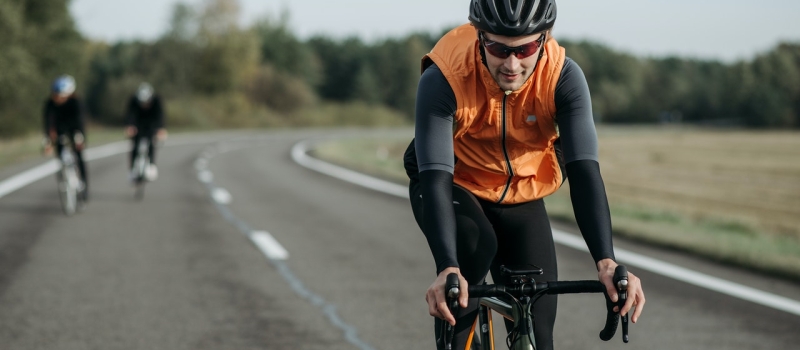Safe Summer Cycling Must Knows
Monday, June 21, 2021 Brenda Griffin

Just recently, four bicyclists were out for a ride in Upstate New York when two were struck by a vehicle leaving one dead at the scene and the other in the hospital. With the uptick in bicyclists hitting the road this summer, both young and not so young, it is important to understand how to share the road safely with other vehicles and pedestrians, so everyone arrives at their destination as planned. Let’s start with the facts, below.
According to the National Highway Traffic Safety Administration, here are some bicycle facts to consideration:
- 846 bicyclists were killed in collisions with vehicles in 2019, up from 718 bicyclist deaths in 2018.
- Bicyclist deaths occurred most often between 6 p.m. and 9 p.m., regardless of the time of year.
- Bicyclist deaths occur most often in urban areas (75%) compared to rural areas (25%) in 2017.
- Bicyclist deaths were 8 times higher for males than females in 2017.
- Alcohol was involved in 37% of all fatal bicyclist crashes in 2017.
Common causes of bike accidents include:
- Speeding. Bicyclists should only ride as fast as is responsible based on road conditions, weather, and how many cars or pedestrians are in the area.
- Distracted riding. Like distracted driving, bicyclists are also tempted to look at their phones when riding. It is never safe to text or use a device for any reason while riding a bike. It is also not the time to be listening to music or podcasts wearing ear buds thus reducing your capability of hearing what is happening in the surroundings.
- Riding too close to traffic. A driver should leave at least 3 feet between their vehicle and cyclists. However, not every driver does, so a bicyclist should always try to stay as far away from other vehicles as possible.
- Lane merges and intersection accidents. Although bicyclists are required to follow the rules of the road, including traffic lights and signals, sometimes they don’t. It is important to use intersections safely and follow traffic signals.
- Accidents in parking lots and driveways. Drivers in parking lot lanes or pulling into or out of driveways might not be looking for bicyclists. Bicyclists need to take their own safety into their own hands by always staying aware of traffic. This also includes watching for drivers exiting their cars while parked along city streets. Likewise, it is also necessary for drivers to watch for bicyclists when they open car doors so as to not cause an accident.
In New York State, a bicyclist must follow the same rules of the road as other motorists. A bicyclist can receive a traffic ticket, and parents are responsible for children’s traffic violations. Below are 12 important laws for New York bicyclists:
- Children under 14 are required to wear a bicycle helmet. Some communities have implemented additional helmet requirements. At the end of the day, all bicyclists should wear one. Here’s data pointing to the risk - 86,439 bicyclists aged 55-64 were treated for traumatic brain injuries (TBI) and broken facial bones from 2008-2017, according to a 2019 Rutgers University study.
- Bicyclists must obey traffic lights and signs. They must also signal turns whether riding on a road, bike lane, or shared-use path.
- Some municipalities prohibit bicycling on sidewalks, though it isn’t a state law. However, the Department of Transportation is clear that sidewalks are intended for pedestrians — not bicyclists — unless they are very young children.
- Bicyclists are entitled to share the road with motor vehicles, except for interstate highways and expressways.
- NYS Vehicle & Traffic Law requires that bicyclists ride with (not against) traffic.
- A bicyclist must use a bike lane where one is available. If there is not one available, a bicyclist may ride on the right shoulder or near the right edge of the road. A cyclist may move left to avoid hazards like parked cards, but they are required to avoid interfering with traffic where possible.
- A driver must provide “due care” to a bicyclist and is responsible for avoiding a collision, allowing sufficient clearance when passing, and giving the right-of-way when necessary.
- A bicyclist must use appropriate hand signals to indicate turns and stopping or slowing.
- Bicyclists may ride two abreast only if there is no other traffic, and they are not permitted to ride more than two abreast even if there’s no traffic. If there are other cars or pedestrians, they must ride single-file.
- Bicyclists may use the same turn lanes as motorists. If they’re turning left, they may use the whole turn lane in order to turn safely.
- If a lane is very narrow (10 feet or fewer), they may “take the lane,” or ride in the center of the lane so cars will not try to pass where it’s too narrow to do so safely.
- A bicyclist must yield the right of way to a pedestrian.
Final tips to ride safely:
- Ride a bike that fits you and works properly, especially the brakes.
- Wear equipment to protect you and make you more visible to others, like a bike helmet, bright clothing (during the day), reflective gear, and a white front light and red rear light and reflectors on your bike (at night, or when visibility is poor).
- Ride one per seat, with both hands on the handlebars, unless signaling a turn.
- Carry all items in a backpack or strapped to the back of the bike.
- Tuck and tie your shoe laces and pant legs so they don’t get caught in your bike chain.
- Plan your route—if driving as a vehicle on the road, choose routes with less traffic and slower speeds. Your safest route may be away from
As you head out for your ride, think of Svend in this Danish Safety Council clip:
Also Worth Reading:




